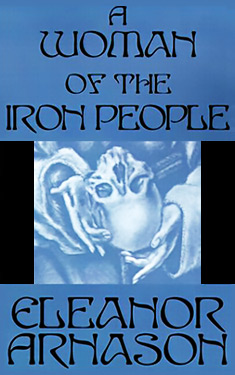Eleanor Arnason
Completed 2/7/2022, Reviewed 2/8/2022
4 stars
This book is another interesting take on first contact by Arnason. It’s sort of similar to her Ring of Swords in that you get the perspective of the aliens trying to determine if the humans are people. It also shares the theme of separation of the sexes due to the aggression of the males. In this book, there are two narrators, Nia of the alien, or more appropriately, the native people, and Lixia of the humans from Earth. Nia’s narration opens and closes the book while Lixia’s is everything in between. It really brings in both sides of the issue of recognizing the Other as equal and important as themselves. This book won the 1992 Mythopoeic Award and the 1991 Otherwise Award.
Nia is one of the furred natives of a planet over 18 light-years away. She is of the Iron People, but she has been exiled for loving a male. Males are kept on the outskirts of villages, tending herds of domesticated animals and only coming into contact with women when the women are in heat. Women do everything else. Nia, for example is a smith. Lixia is one of the first explorers from Earth on the planet. She encounters the village Nia lives and works in. The furred women are shocked at the difference of Lixia and wonder if she is a demon or a spirit. The village women pawn her off on Nia, who kind of resents it at first. But eventually they travel together to go back to the Iron People and become friends. Lixia has a gift for languages and picks up their language quickly. Back on the spaceship, the people from Earth are fighting over whether contact interferes with the natural development of the native population. All the while, Lixia tries to learn all she can from Nia and the others they encounter.
Lixia and Nia are really great characters. Nia is introverted and stoic. She takes everything as it comes, as she did her exile. She’s a little like a man, not really liking being around people, which is why she doesn’t want to play tour guide for Lixia. Soon, however, she comes to really care for Lixia and takes seriously the conflict of the crew aboard the spaceship. Lixia is a bit on the perfect side, the ultimate anthropologist. She does everything she can to limit her explanation of human technology to this pre-technological society. At the same time, she finds a way to learn so much about the Indigenous population. Along the way, they acquire a male on their journey who happens to be holy and crazy. The spirits of the waterfall talk to him and they tell him he must follow Lixia. Rounding out this group is Derek, another anthropologist who is a bit full of himself, but not too obnoxious. I like him as well, after a while.
The world building is terrific. Arnason does an amazing job with this society and planet. Her prose is terrific as well. It is descriptive without being overbearing. There were only a few times when I thought that she went on about insignificant details. Altogether it makes for a quick, easy read. There’s a glossary for pronunciation that I wish I had found earlier. When I got to the end and found the glossary, I was kind of bummed that I had been pronouncing things wrong in my head.
Through most of my reading, I wondered why this science fiction book would win a Mythopoeic Award. It eventually dawned on me that it’s because Arnason creates a robust culture complete with stories of their mythology. I enjoyed the little group’s forays into the different villages and how the women reacted to their presence.
I give this book four stars out of five. It’s a terrific first contact story with the prime directive trope (from Star Trek) and a fascinating take on the sexes. I don’t think this is an easy book to find, but it is available electronically. My library had the e-book.

No comments:
Post a Comment